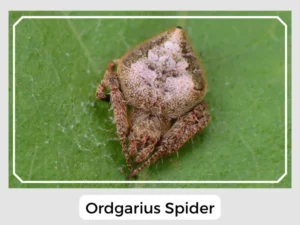The Ordgarius is a unique group of orb-weaver spiders with twelve species identified by 2019. Among them, the Ordgarius magnificus or Magnificent Spider stands out as the most notable. Explore this post to discover intriguing facts about these fascinating creatures.
The egg sacs remain clustered in the brown egg sacs mostly kept amidst foliages.
Not much information has been obtained about the spiderlings, though like most other species they too live on their own after maturation.
Two spiders of this genus, namely, the Ordgarius magnificus and Ordgarius hobsoni, do not generally spin wheel-shaped or spiral webs like other members of the orb-weaver family. They are bolas spiders, capturing their prey by throwing or swinging a bolas (sticky blob attached to one end of a silken line) at them.
Yes, like most spiders, Ordgarius spiders have venom. However, their venom is not harmful to humans and is primarily used to immobilize their prey.
While Ordgarius spiders can bite, they usually avoid humans and are not considered aggressive. Bites are rare and often result from accidental contact.
Ordgarius spiders, particularly the bolas species, play a crucial role in the control of moth and butterfly populations, serving as natural pest regulators. Their non-conventional hunting technique is an evolutionary marvel, allowing them to selectively target and capture flying insects.
Natural Predators: These spiders are preyed upon by birds, larger spiders, and other predators within their forest ecosystems. This predation is a natural form of population control, ensuring ecological balance.
Prey-Predator Dynamics: The prey-predator relationship exhibited by Ordgarius spiders is complex and beneficial to their ecosystems. By preying on various insects, they help to keep these populations in check, thus contributing to the health of their habitats.
Relationship with Humans: Although Ordgarius spiders are venomous, they are not a threat to humans. Their venom is designed to immobilize small prey, not to defend against large mammals like humans. Interactions with these spiders are rare, as they tend to avoid human contact and are not aggressive.
| Distribution | Parts of Australia (Queensland and New South Wales) and Asia (India, Srilanka, Vietnam, Myanmar, Japan, Indonesia) |
| Habitat | Mostly in the forest areas |
| Diet | Mostly insects; some of them particularly the bolas spiders would feed on moths, butterflies, beetles, and pests |
| Lifespan | Approximately 1 year like most other orb-weavers |

In conclusion, the Ordgarius genus, with its diverse species and unique predatory methods, is an integral part of the ecosystem.
The Ordgarius is a unique group of orb-weaver spiders with twelve species identified by 2019. Among them, the Ordgarius magnificus or Magnificent Spider stands out as the most notable. Explore this post to discover intriguing facts about these fascinating creatures.
The egg sacs remain clustered in the brown egg sacs mostly kept amidst foliages.
Not much information has been obtained about the spiderlings, though like most other species they too live on their own after maturation.
Two spiders of this genus, namely, the Ordgarius magnificus and Ordgarius hobsoni, do not generally spin wheel-shaped or spiral webs like other members of the orb-weaver family. They are bolas spiders, capturing their prey by throwing or swinging a bolas (sticky blob attached to one end of a silken line) at them.
Yes, like most spiders, Ordgarius spiders have venom. However, their venom is not harmful to humans and is primarily used to immobilize their prey.
While Ordgarius spiders can bite, they usually avoid humans and are not considered aggressive. Bites are rare and often result from accidental contact.
Ordgarius spiders, particularly the bolas species, play a crucial role in the control of moth and butterfly populations, serving as natural pest regulators. Their non-conventional hunting technique is an evolutionary marvel, allowing them to selectively target and capture flying insects.
Natural Predators: These spiders are preyed upon by birds, larger spiders, and other predators within their forest ecosystems. This predation is a natural form of population control, ensuring ecological balance.
Prey-Predator Dynamics: The prey-predator relationship exhibited by Ordgarius spiders is complex and beneficial to their ecosystems. By preying on various insects, they help to keep these populations in check, thus contributing to the health of their habitats.
Relationship with Humans: Although Ordgarius spiders are venomous, they are not a threat to humans. Their venom is designed to immobilize small prey, not to defend against large mammals like humans. Interactions with these spiders are rare, as they tend to avoid human contact and are not aggressive.
| Distribution | Parts of Australia (Queensland and New South Wales) and Asia (India, Srilanka, Vietnam, Myanmar, Japan, Indonesia) |
| Habitat | Mostly in the forest areas |
| Diet | Mostly insects; some of them particularly the bolas spiders would feed on moths, butterflies, beetles, and pests |
| Lifespan | Approximately 1 year like most other orb-weavers |

In conclusion, the Ordgarius genus, with its diverse species and unique predatory methods, is an integral part of the ecosystem.